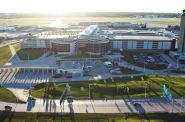County Finalizing Deal for Forensic Science Center
County Board must agree to release more than $100 million in funding for project.
Milwaukee County officials are in the process of finalizing a complicated real estate deal with the state of Wisconsin and the Medical College of Wisconsin. If everything goes according to plan, the result will be a new $226 million Center for Forensic Science and Protective Medicine, a facility which has been in planning for months.
Before the legal paperwork is finalized and all the signatures applied, the Department of Administrative Services (DAS) is going before the Milwaukee County Board of Supervisors and asking it to release approximately $112.3 million currently held in an account controlled by the board.
Aaron Hertzberg, DAS director, told the board’s Finance Committee that his department needs the funds released in order to move the project forward. If the funds aren’t released during this board cycle, he said, it could throw off the construction timeline and the building wouldn’t be completely enclosed by the arrival of winter adding “a lot more complexity to the project” and the potential for “a multimillion-dollar impact.” Construction is expected to begin in 2023 and be completed by December 2025 with the county moving in by February 2026.
Given that the agreement is still in draft form, Hertzberg was asking the supervisors to work with DAS and its partner; and so far the board is. The committee recommended the funds be released and next the board will vote on final approval.
The plan calls for a three-story, 212,000-square-foot building that would be constructed on the Milwaukee Regional Medical Center (MRMC) campus. The new facility will be built on land owned by the county. The state is paying $99.5 million for just less than half the building, which will house the state Department of Justice Milwaukee Crime Lab. The county is paying approximately $100 million for its portion of the building (approximately 108,000 square feet) which will house the Office of the Medical Examiner and the county’s Office of Emergency Management, and another $27 million to build out the space. Part of the deal also involves a ground lease with the Medical College of Wisconsin, which will hold the land on behalf of the county at no cost, Hertzberg said.
The project developer is CD Smith. The county will pay the Milwaukee-based construction firm a $1 million down payment when the agreement is finalized, and the bulk of the development cost will be paid upon completion. Given this deal structure, CD Smith will have to seek commercial loans and the final cost of the development will include the interest on that loan.
Hertzberg told supervisors that DAS is working with the Office of the Comptroller on a potential plan for reimbursing CD Smith for construction costs at various stages of development in order to “help reduce the exposure to interest rates.”
The project is located in the medical hub of the metro Milwaukee region, and should offer new opportunities for collaboration between the county, the state and the healthcare institutions in the MRMC, ranging from improved disaster preparedness and response to new research opportunities, according to DAS officials. The building would also allow for collaboration between the medical examiner and the state crime lab.
But the most pressing issue is the need for a new facility for the medical examiner’s office, now located in a deteriorating building long past its useful life at 933 W. Highland Ave. The new facility is also expected to improve the medical examiner’s recruitment efforts: the office is struggling to recruit during a national shortage of forensic pathologists. The former chief medical examiner Brian L. Peterson in September uttered the now infamous description of the building’s disrepair, saying “I mean, when you can walk into our front lobby and smell decomposed body on a lot of days, that’s just not good.”
Political Contributions Tracker
Displaying political contributions between people mentioned in this story. Learn more.


























Is this the same county that claims it cannot fix the Domes?
While the state’s huge surplus could allow the funding of many vital public services and projects, Madison’s shortsighted Republican majority will in all likelihood blow this one time opportunity in favor of returning miniscule amounts to middle class taxpayers and far greater sums to their corporate clientele. What’s new?